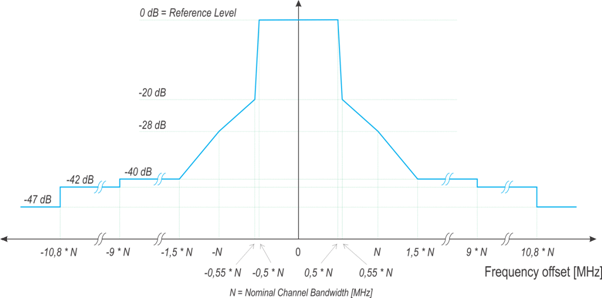Dear all,
The BRAN committee has one more meeting to go before the next version (v 1.8.1) of the 5 GHz testing spec will be sent for national vote.
In the present draft (in this regard the same as http://www.ieee802.org/11/private/ETSI_documents/BRAN/70-Draft/0060011/BRAN-0060011v004.doc ) we find, inherited from the existing version v 1.7.1, the following about nominal bandwidth:
“NOTE: During an established communication, a device is allowed to operate temporarily in a mode where its Occupied Channel Bandwidth may be reduced to as low as 40 % of its Nominal Channel Bandwidth with a minimum of 4 MHz.”
This looks like it’s targeted at 20 MHz PPDU in 40 MHz mask[1] from 802.11n. Since the 802.11ac amendment has now been published, there will be a mode which does not fit in this limit, the 20 MHz PPDU in 80 MHz mask.
Do we want to raise this at the next BRAN meeting in June? We could make a reasoned argument that 20% is a perfectly good value for that limit.
Detailed problem explanation courtesy of my colleague Alex Thoukydides on the question of whether 80 MHz could be considered as one 80 MHz with occasional fractional use (disallowing 20 in 80 because of the percentage) or as four 20 MHz which were transmitting together most of the time (which would appear to be fine, but...) :
The problem with taking the interpretation that the IEEE 802.11n/ac channel bandwidth is always 20MHz, and that 40/80/80+80/160MHz are formed by simultaneous operation on multiple channels, is that it then requires compliance with the 20MHz spectral mask (Figure 1 from ETSI EN 301 893 clause 4.5.2.2):

Considering the case of an IEEE 802.11ac network using 80MHz bandwidth:
80MHz channel 42: 5,170-5,250MHz, centre frequency 5,210MHz
40MHz primary channel 36: 5,170-5,210MHz, centre frequency 5,190MHz
20MHz primary channel 36: 5,170-5,190MHz, centre frequency 5,180MHz
40MHz secondary channel 44/48: 5,210-5,250MHz, centre frequency 5,230MHz
20MHz secondary channel 40: 5,190-5,210MHz, centre frequency 5,200MHz
Most implementations would leave their LO tuned to 5,210MHz and their analogue filters set for the 80MHz bandwidth, regardless of whether they are using the full 80MHz bandwidth, or just the primary 40MHz or primary 20MHz channel.
Let's start by considering transmission of a full 80MHz channel bandwidth modulation. This should be the simple case. For an 80MHz mask transmission the IEEE 802.11ac standard requires the emissions to be under -28dBr by ±80MHz, and below -40dBr by ±120MHz. If the nominal channel bandwidth is considered to be 80MHz then the ETSI requirements are the same, but if instead it is treated as being simultaneous use of multiple 20MHz nominal channels then ETSI require -28dBr by ±50MHz, and below -40dBr by ±60MHz. This is a much tougher requirement.
Fortunately clause 4.5.2.2 allows the wider bandwidth to be applied: "For transmitter unwanted emissions within the 5 GHz RLAN bands, simultaneous transmissions in adjacent channels may be considered as one signal with an actual Nominal Channel Bandwidth of "n" times the individual Nominal Channel Bandwidth where "n" is the number of adjacent channels used simultaneously."
If we then consider the other extreme of a 20MHz channel bandwidth modulation on the primary 20MHz channel. The IEEE 802.11ac standard allows the same 80MHz mask to be applied, so no problems there. The 20MHz/80MHz utilisation falls below the allowance in ETSI EN 301 893 clause 4.3.2 that the "Occupied Channel Bandwidth may be reduced to as low as 40 % of its Nominal Channel Bandwidth" so we need to treat this as having a 20MHz nominal channel bandwidth, so the mask needs to reach -28dBr by ±20MHz (-50 to -10MHz relative to LO), and below -40dBr by ±30MHz (-60 to 0MHz relative to LO). There will be no analogue filtering to help with the high end of this frequency range, and in particular there will be LO leakage at 5,210MHz where the IEEE 802.11ac allowance is -32dB relative to the total transmit power, but ETSI requires -40dB relative to the peak power density in 1MHz bandwidth.
Best Regards
Jens
[1] “40 MHz mask physical layer convergence procedure (PLCP) protocol data unit (PPDU) .. 3) a Clause 20 20 MHz HT PPDU with the TXVECTOR parameter CH_BANDWIDTH equal to HT_CBW20” from 802.11-2012 p 25 clause 3.2 (which was the most recent published amendment targeted by ETSI BRAN when this draft was started – 802.11n)
Jens TINGLEFF
Principal Engineer, Radio Systems and Integration
Samsung France Research Center
E-Space Park Bat C
45, Allee des Ormes
06250 Mougins
France
Phone: +33 (0)4 89 73 70 14
Mobile: +33 (0)6 86 64 86 72
Fax: +33 (0)4 89 73 70 01
If you wish to be removed from this reflector, do not send your request to this reflector - it will have no effect.
Instead, go to http://listserv.ieee.org/cgi-bin/wa?SUBED1=STDS-802-11-REG and then press the LEAVE button.
Further information can be found at: http://www.ieee802.org/11/Email_Subscribe.html _______________________________________________________________________________